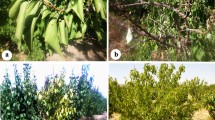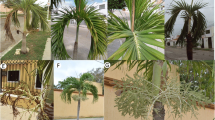Abstract
About 40 different species of wild herbaceous and woody plants were collected in underbrush close to a vineyard where Flavescence dorée (FD) has been reported for several years. Polymerase chain reaction assays were carried out using DNA extracted from leaves of each species for the detection of the presence of phytoplasmas. Only samples of Clematis vitalba were found to be infected with phytoplasmas. Restriction fragment length polymorphism and sequencing data of the 16S ribosomal RNA gene and of a non-ribosomal DNA fragment FD9 revealed that the phytoplasma isolate was identical to that causing FD in the nearby vineyard. The isolate identified in the clematis is the same as the FD-C phytoplasma found in grapevine in north-east Italy.
Similar content being viewed by others
References
Alma A, Davis RE, Vibio M, Danielli A, Bosco D, Arzone A and Bertaccini A (1996) Mixed infection of grapevines in Northern Italy by phytoplasmas including 16S rRNA RFLP subgroup 16SrI-B strains previously unreported in this host. Plant Disease 80: 418-421
Alma A, Marzachí C, d'AquilioM and Bosco D (2000) Cyclamen (Cyclamen persicum L.): A dead-end host species for 16Sr-IB and-IC subgroup phytoplasmas. Annals of Applied Biology 136: 173-178
Alma A, Palermo S, Boccardo G and Conti M (2001) Transmission of chrysanthemum yellows, a subgroup 16SrI-B phytoplasma, to grapevine by four leafhopper species. Journal of Plant Pathology 83: 181-187
Angelini E, Clair D, Borgo M, Bertaccini A and Boudon-Padieu E (2001) Flavescence dorée in France and Italy-occurrence of closely related phytoplasma isolates and their near relationships to Palatinate grapevine yellows and an alder phytoplasma. Vitis 40: 79-86
Angelini E, Negrisolo E, Clair D, Borgo M and Boudon-Padieu E (2003) Phylogenetic relationships among Flavescence dorée strains and related phytoplasmas determined by heteroduplex mobility assay and sequence of ribosomal and non-ribosomal DNA. Plant Pathology, accepted.
Barnett DE (1976) A revision of the Nearctic species of the genus Scaphoideus (Homoptera: Cicadellidae). Transactions of American Entomological Society 102: 485-593
Bertaccini A (2002) Il punto sull'epidemia di flavescenza dorata in Italia. L'Informatore Agrario 15: 97-98
Borgo M and Angelini E (2002) Diffusione della flavescenza dorata della vite in Italia e relazioni con vitigni, pratiche agronomiche e materiali di propagazione. Atti Giornate Fitopatologiche 1: 35-50
Borgo M, Angelini E and Bertotto L(2002) Flavescenza dorata nel Veneto. La situazione nella provincia di Treviso. L'Informatore Agrario 24: 8-9
Boudon-Padieu E (2000) Recent advances on grapevine yellows: Detection, etiology, epidemiology and control strategies. In: 13th Meeting ICVG, Extended abstracts: 87-88
Caudwell A, Kuszala C, Bachelier JC and Larrue J (1970) Transmission de la Flavescence dorée de la vigne aux herbacées par l'allongement du temps d'utilisation de la cicadelle Scaphoideus littoralis Ball et l'étude de sa survie sur un grand nombre d'espèces végétales. Annales de Phytopathologie 2: 415-428
Chao KM, Pearson WR and Miller W (1992) Aligning two sequences within a specified diagonal band. Computer Applications in the Biosciences 8: 481-487
Daire X, Boudon-Padieu E, Bervillé A, Schneider B and Caudwell A (1992) Cloned DNA probes for detection of grapevine Flavescence dorée mycoplasma-like organism (MLO). Annals of Applied Biology 121: 95-103
Daire X, Clair D, Reinert W and Boudon-Padieu E (1997) Detection and differentiation of grapevine yellows phytoplasmas belonging to the elm yellows group and to the stolbur subgroup by PCR amplification of non-ribosomal DNA. European Journal of Plant Pathology 103: 507-514
Davis RE, Dally EL, Gundersen DE, Lee IM and Habili N (1997) 'Candidatus Phytoplasma australiense', a new phytoplasma taxon associated with Australian grapevine yellows. International Journal of Systematic Bacteriology 47: 262-269
Davis RE, Jomantiene R, Dally EL and Wolf TK (1998) Phytoplasma associated with grapevine yellows in Virginia belong to group 16SrI, subgroup A (tomato big bud phytoplasma subgroup) and group 16SrIII, new subgroup I. Vitis 37: 131-137
Deng S and Hiruki C (1991) Amplification of 16S rRNA genes from culturable and non-culturable Mollicutes. Journal of Microbiological Methods 14: 53-61
Gatineau F, Larrue J, Clair D, Lorton F, Richard-Molard M and Boudon-Padieu E (2001) A new natural planthopper vector of stolbur phytoplasma in the genus Pentastiridius (Hemiptera: Cixiidae). European Journal of Plant Pathology 107: 263-271
Gibb KS, Padovan AC and Mogen BD (1995) Studies on sweet potato little-leaf phytoplasma detected in sweet potato and other plants species growing in northern Australia. Phytopathology 85: 169-174
Gibb KS, Constable FE, Moran JR and Padovan AC (1999) Phytoplasmas in Australian grapevines-detection, differentiation and associated diseases. Vitis 38: 107-114
Griffith HM, Sinclair WA, Boudon-Padieu E, Daire X, Lee IM, Sfalanga A and Bertaccini A (1999) Phytoplasmas associated with elm yellows: Molecular variability and differentiation from related organisms. Plant Disease 83: 1101-1104
Gundersen DE and Lee IM (1996) Ultrasensitive detection of phytoplasmas by nested-PCR assays using two universal primer pairs. Phytopathologia Mediterranea 35: 144-151
Harrison NA, Griffith HM, Carpio ML and Richardson PA (2002) Detection and characterization of an elm yellows (16SrV) group phytoplasma infecting Virginia creeper plants in southern Florida. Plant Disease 85: 1055-1062
Lee IM, Gundersen DE, Hammond RW and Davis RE (1994) Use of Mycoplasmalike organisms (MLO) group-specific oligonucleotide primers for nested-PCR assay to detect mixed-MLO infections in a single host plant. Phytopathology 84: 559-566
Lee IM, Gundersen-Rindal DE, Davis RE and Bartoszyk IM (1998) Revised classification scheme of Phytoplasmas based on RFLP analyses of 16S rRNA and ribosomal protein gene sequences. International Journal of Systematic Bacteriology 48: 1153-1169
Maixner M, Ahrens U and Seemüller E (1995) Detection of the German grapevine yellows (Vergilbungskrankheit) MLO in grapevine, alternative hosts and a vector by a specific PCR procedure. European Journal of Plant Pathology 101: 241-250
Maixner M and Reinert W (1999) Oncopsis alni (Schrank) (Auchenorrhyncha: Cicadellidae) as a vector of the alder yellows phytoplasma of Alnus glutinosa (L.) Gaertn. European Journal of Plant Pathology 105: 87-94
Maixner M, Reinert W and Darimont H (2000) Trasmission of grapevine yellows by Oncopsis alni (Schrank) (Auchenorrhyncha: Macropsinae). Vitis 39: 83-84
Marcone C, Ragozzino A and Seemüller E (1997) Identification and characterization of the phytoplasma associated with elm yellows in southern Italy and its relatedness to other phytoplasmas of the elm yellows group. European Journal of Forestal Pathology 27: 45-54
Martini M, Murari E, Mori N and Bertaccini A (1999) Identification and epidemic distribution of two Flavescence dorée-related phytoplasmas in Veneto (Italy). Plant Disease 83: 925-930
Martini M, Botti S, Marcone C, Marzachí C, Casati P, Bianco PA, Benedetti R and Bertaccini A (2002) Genetic variability among Flavescence dorée phytoplasmas from different origins in Italy and France. Molecular and Cellular Probes 16: 197-203
Padovan AC, Gibb KS, Bertaccini A, Vibio M, Bonfiglioli RE, Magarey PA and Sears BB (1995) Molecular detection of the Australian grapevine yellows phytoplasmas and comparison with grapevine yellows phytoplasmas from Italy. Australian Journal of Grape and Wine Research 1: 25-31
Pignatti S (1997) Flora d'Italia. Vol. 1-3, Edagricole, Bologna
Reinert W (1999) Detektion und Differenzierung rebpathogener Phytoplasmen (Mollicutes, Eubacteria) in Deutschland unter Berücksichtigung phytopathologischer Aspekte. PhD dissertation, Dem Fachbereich Biologie der Technischen Universität Darmstadt
Schvester D, Carle P and Moutous G (1961) Sur la transmission de la Flavescence dorée des vignes par une cicadelle. Comptes Rendus des Séances de l'Académie d'Agriculture de France 47: 1021-1024
Seemüller E, Marcone C, Lauer U, Ragozzino A and Göschl M (1998) Current status of molecular classification of the phytoplasmas. Journal of Plant Pathology 80: 3-26
Sforza R, Clair D, Daire X., Larrue J and Boudon-Padieu E (1998) The role of Hyalesthes obsoletus (Hemiptera: Cixiidae) in the occurrence of Bois noir of grapevine in France. Journal of Phytopathology 146: 549-556
Smart CD, Schneider B, Blomquist CL, Guerra LJ, Harrison NA, Ahrens U, Lorenz KH, Seemüller E and Kirckpatrick BC (1996) Phytoplasma-specific PCR primers based on sequences of the 16S-23S rRNA spacer region. Applied and Environmental Microbiology 62: 1988-1993
Thompson JD, Higgins DG and Gibson TJ (1994) CLUSTAL W: Improving the sensitivity of progressive multiple sequence alignment through sequence weighting, position-specific gap penalties and weight matrix choice. Nucleic Acids Research 22: 4673-4680
Varga K, Kölber M, Martini M, Pondrelli M, Ember I, Tökés G, Lázár J, Mikulás J, Papp E, Szendrey G, Schweigert A and Bertaccini A (2000) Phytoplasma identification in Hungarian grapevines by two nested-PCR systems. In: 13th Meeting ICVG, Extended abstracts: 113-115
Author information
Authors and Affiliations
Rights and permissions
About this article
Cite this article
Angelini, E., Squizzato, F., Lucchetta, G. et al. Detection of a Phytoplasma Associated with Grapevine Flavescence dorée in Clematis vitalba . European Journal of Plant Pathology 110, 193–201 (2004). https://doi.org/10.1023/B:EJPP.0000015361.95661.37
Issue Date:
DOI: https://doi.org/10.1023/B:EJPP.0000015361.95661.37




